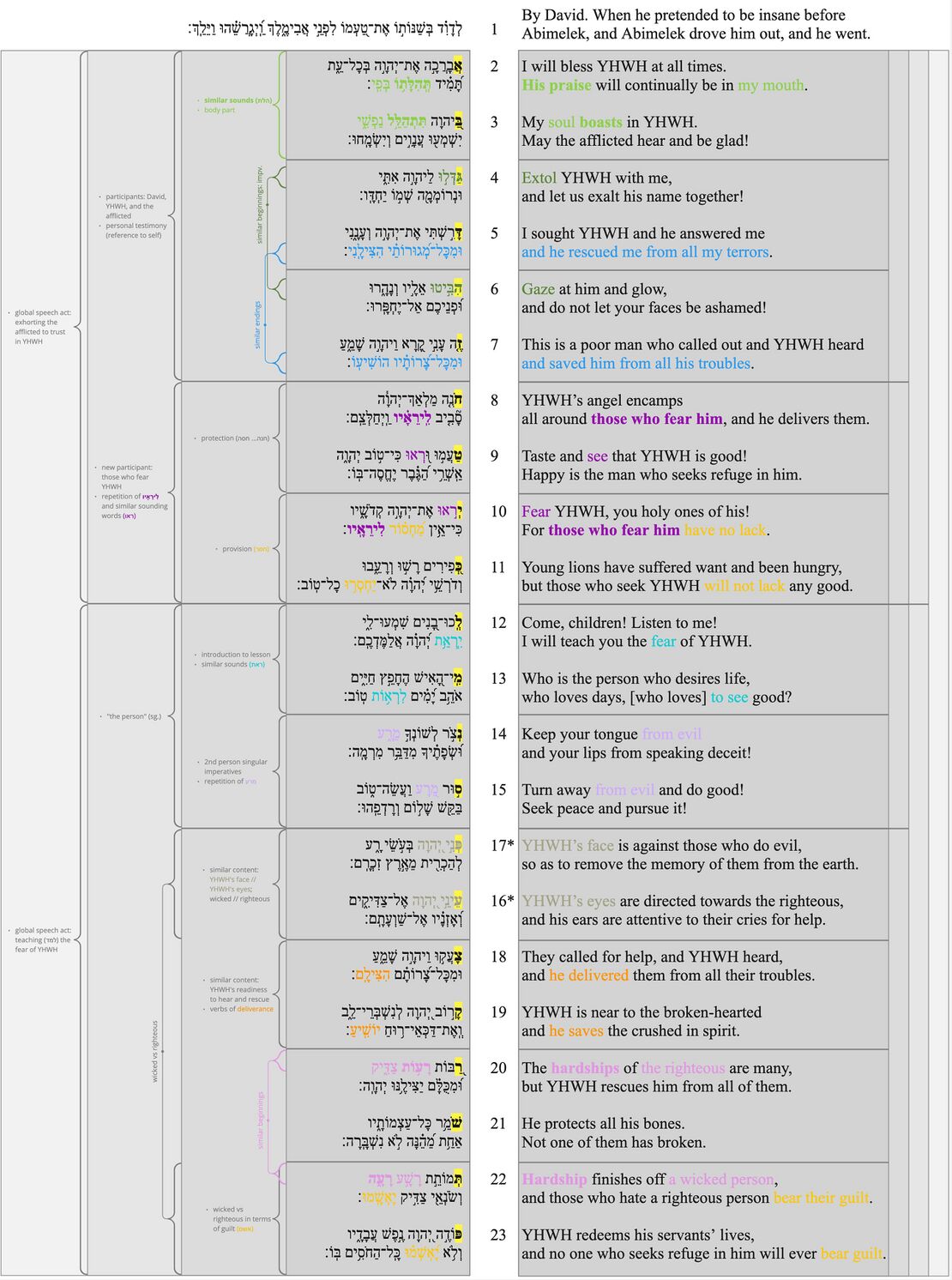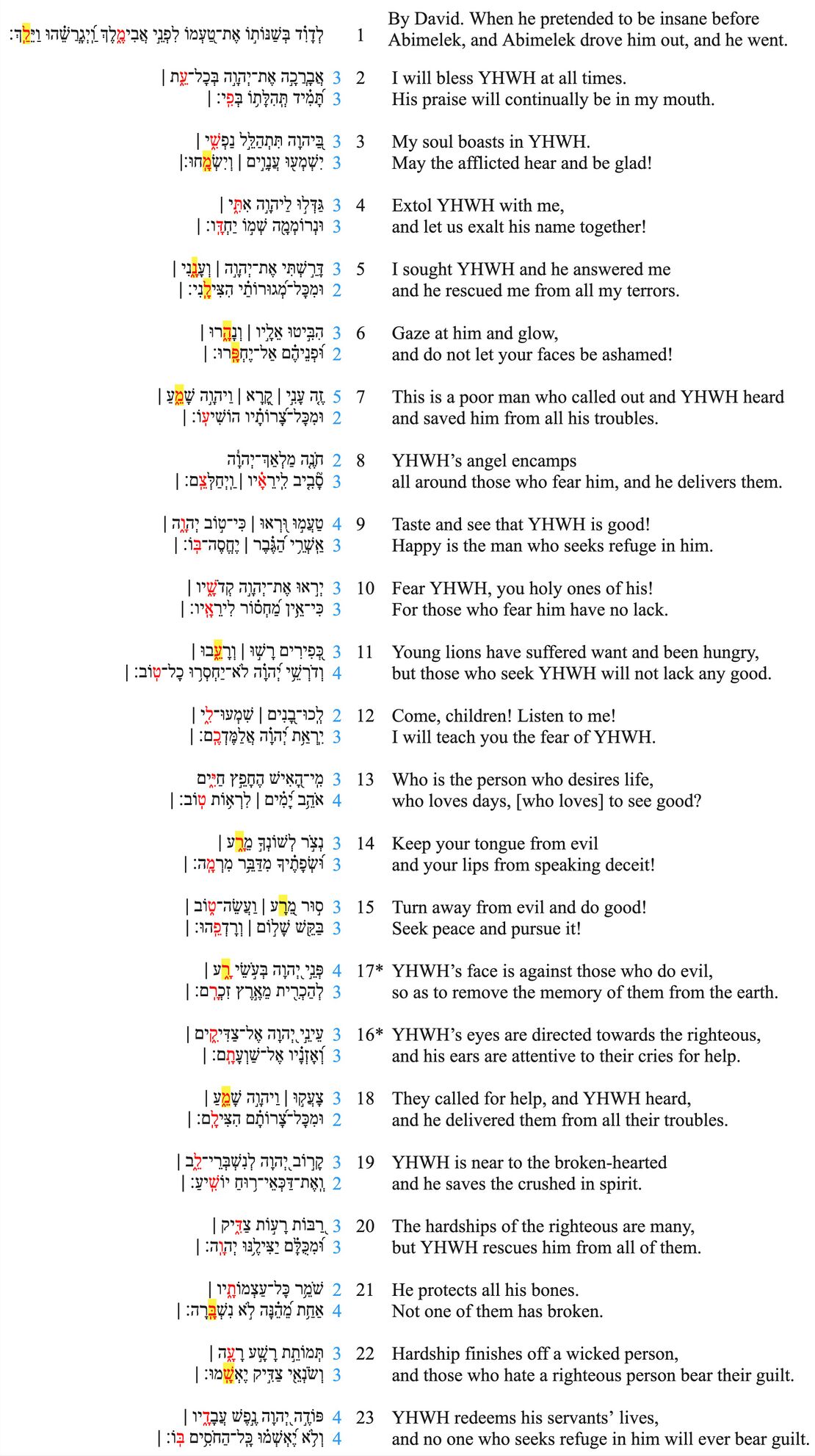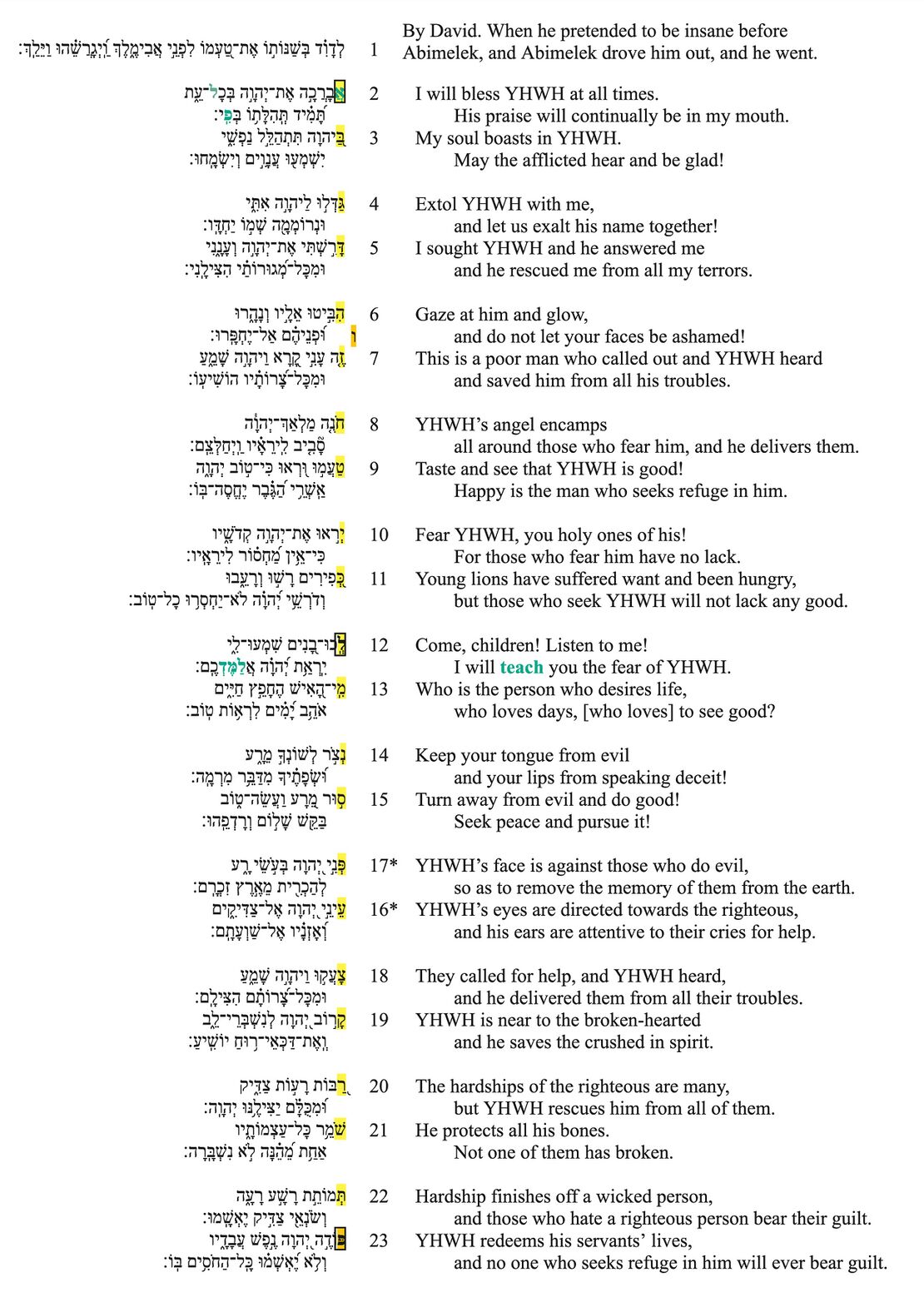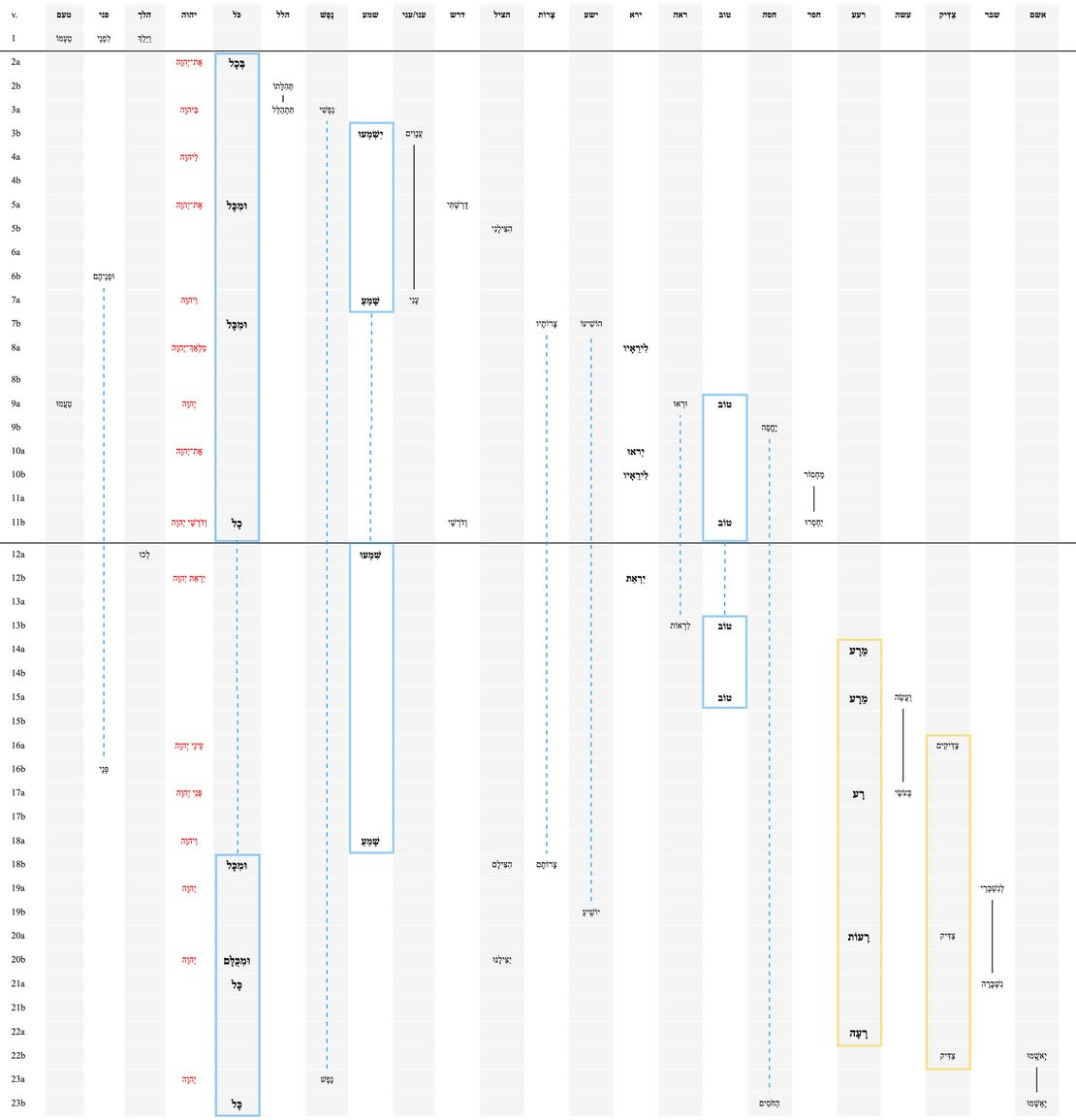Psalm 34 Poetry
About the Poetics Layer
Exploring the Psalms as poetry is crucial for understanding and experiencing the psalms and thus for faithfully translating them into another language. This layer is comprised of two main parts: Poetic Structure and Poetic Features.
Poetic Structure
In poetic structure, we analyse the structure of the psalm beginning at the most basic level of the structure: the line (also known as the “colon” or “hemistich”). Then, based on the perception of patterned similarities (and on the assumption that the whole psalm is structured hierarchically), we argue for the grouping of lines into verses, verses into strophes, strophes into stanzas, etc. Because patterned similarities might be of various kinds (syntactic, semantic, pragmatic, sonic) the analysis of poetic structure draws on all of the previous layers (especially the Discourse layer).
Poetic Features
Bibliography
- Allegro, John Marco. 1955.“Uses of the Semitic Demonstrative Element Z in Hebrew.” Vetus Testamentum, vol. 5, no. 3 July: pp. 309–12.
- Baethgen, Friedrich. 1904. Die Psalmen. Göttingen: Vandenhoeck und Ruprecht.
- Bratcher, Robert G., and William D. Reyburn. 1991. A Handbook on Psalms. UBS Handbook Series. New York: United Bible Societies.
- Ceresko, Anthony. 1985. “The ABCs of Wisdom in Psalm Xxxiv.” VT 35: 99–104.
- Craigie, Peter C. 2004. Psalms 1–50. WBC 19. Waco, TX: Word.
- Delitzsch, Franz. Biblical Commentary on the Psalms: Vol. 1. Translated by Eaton David. Vol. 1. New York: Funk and Wagnalls, 1883.
- Eriksson, Lars Olov. 1991. “Come, Children, Listen to Me!”: Psalm 34 in the Hebrew Bible and in Early Christian Writings. Coniectanea Biblica 32. Stockholm: Almquist & Wiksell.
- Fokkelman, J.P. 2003. Major Poems of the Hebrew Bible: At the Interface of Prosody and Structural Analysis (Vol 3: The Remaining 65 Psalms). Vol. 3. Studia Semitica Neerlandica. Van Gorcum.
- Freedman, David Noel. 1992. "Patterns in Psalms 25 and 34", in Priests, Prophets, and Scribes JSOT 149, Sheffield: Sheffield Academic Press.
- Gentry, Peter. 2013. "The Meaning of 'Holy' in the Old Testament." Bibliotheca Sacra 170, no. 677-680: 400-417.
- Goldingay, John. 2006. Psalms: Psalms 1–41. Vol. 1. BCOT. Grand Rapids: Baker Academic, 2006.
- Gunkel, Hermann. Die Psalmen. 4th ed. Göttinger Handkommentar Zum Alten Testament 2. Göttingen: Vandenhoeck & Ruprecht, 1926.
- Hossfeld, Frank-Lothar, and Erich Zenger. 1993. Die Psalmen I: Psalm 1–50. Neue Echter Bibel. Würzburg: Echter.
- Hupfeld, Hermann. 1868. Die Psalmen. Vol. 2. Gotha: Friedrich Andreas Perthes.
- Jenni, Ernst. 1992. Die Hebräischen Präpositionen Band 1: Die Präposition Beth. Stuttgart: W. Kohlhammer.
- ___. 2000. Die Hebräischen Präpositionen Band 3: Die Präposition Lamed. Stuttgart: Verlag W. Kohlhammer.
- Kimhi, David. 1900. The Book of Psalms, with commentary. Berlin, Schocken.
- Krohn, Rachel. 2021. “A Syntactic Description of Biblical Hebrew Poetry: The Revised and Extended Hebrew Verse Structure Model.” Doctoral thesis.
- Locatell, Christian S. 2017. “Grammatical Polysemy in the Hebrew Bible: A Cognitive Linguistic Approach to כי.” PhD Dissertation, University of Stellenbosch.
- López, René A. 2010. "Identifying the 'Angel of the Lord' in the Book of Judges." Bulletin for Biblical Research 20 (1):1-18.
- Lugt, Pieter van der. 2006. Cantos and Strophes in Biblical Hebrew Poetry: With Special Reference to the First Book of the Psalter. Vol. 1. 3 vols. Oudtestamentische Studiën 53. Leiden: Brill.
- Lunn, Nicholas P. 2006. Word-Order Variation in Biblical Hebrew Poetry: Differentiating Pragmatics and Poetics. Paternoster Biblical Monographs. Milton Keynes: Paternoster.
- Malone, Andrew S. 2011. "Distinguishing the Angel of the Lord." Bulletin for Biblical Research 21 (3): 297-314.
- Milgrom, Jacob. 1991. Leviticus 1–16. New York: Doubleday.
- Miller, Cynthia L. 2010. “Vocative Syntax in Biblical Hebrew Prose and Poetry: A Preliminary Analysis.” Semitic Studies 55, no. 1: 347–64.
- Revell, E.J. 1996. The Designation of the Individual: Expressive Usage in Biblical Narrative. (Contributions to Biblical Exegesis and Theology 14.) Kampen: Kok Pharos.
- Roberts, J. J. M. 1973. “The Young Lions of Psalm 34, 11.” Biblica 54, no. 2: 265–67.
- Rogland, Max. 2003. Alleged Non-Past Uses of Qatal in Classical Hebrew. Assen, The Netherlands: Royal van Gorcum.
- Sanders, Paul. Forthcoming. "A Long Life as a Blessing in the Old Testament and the Ancient Levant."
- Skehan, Patrick William. 1951. “Structure of the Song of Moses in Deuteronomy (Deut 32:1-43).” The Catholic Biblical Quarterly 13, no. 2 (April 1951).
- Strawn, Brent A. 2005. What is Stronger than a Lion? Leonine Image and Metaphor in the Hebrew Bible and the Ancient Near East. Fribourg, Switzerland: Academic Press Fribourg.






